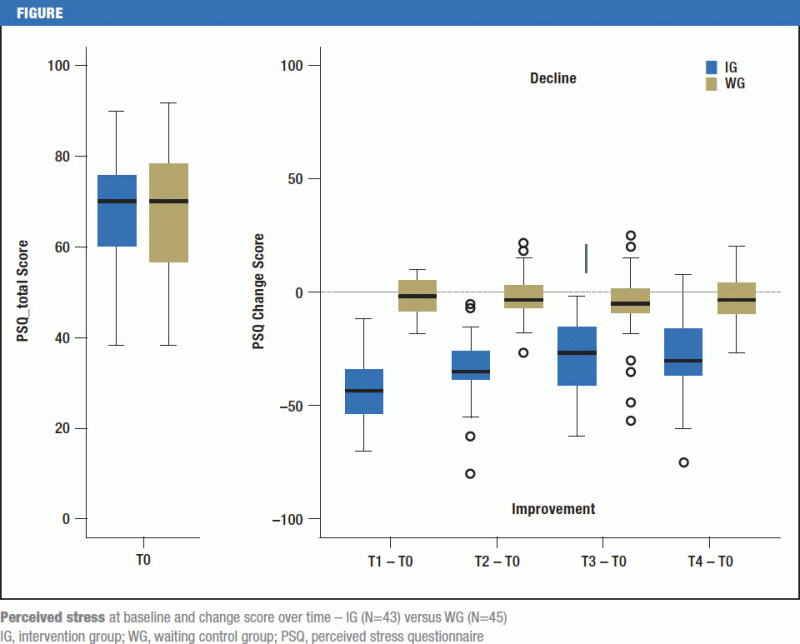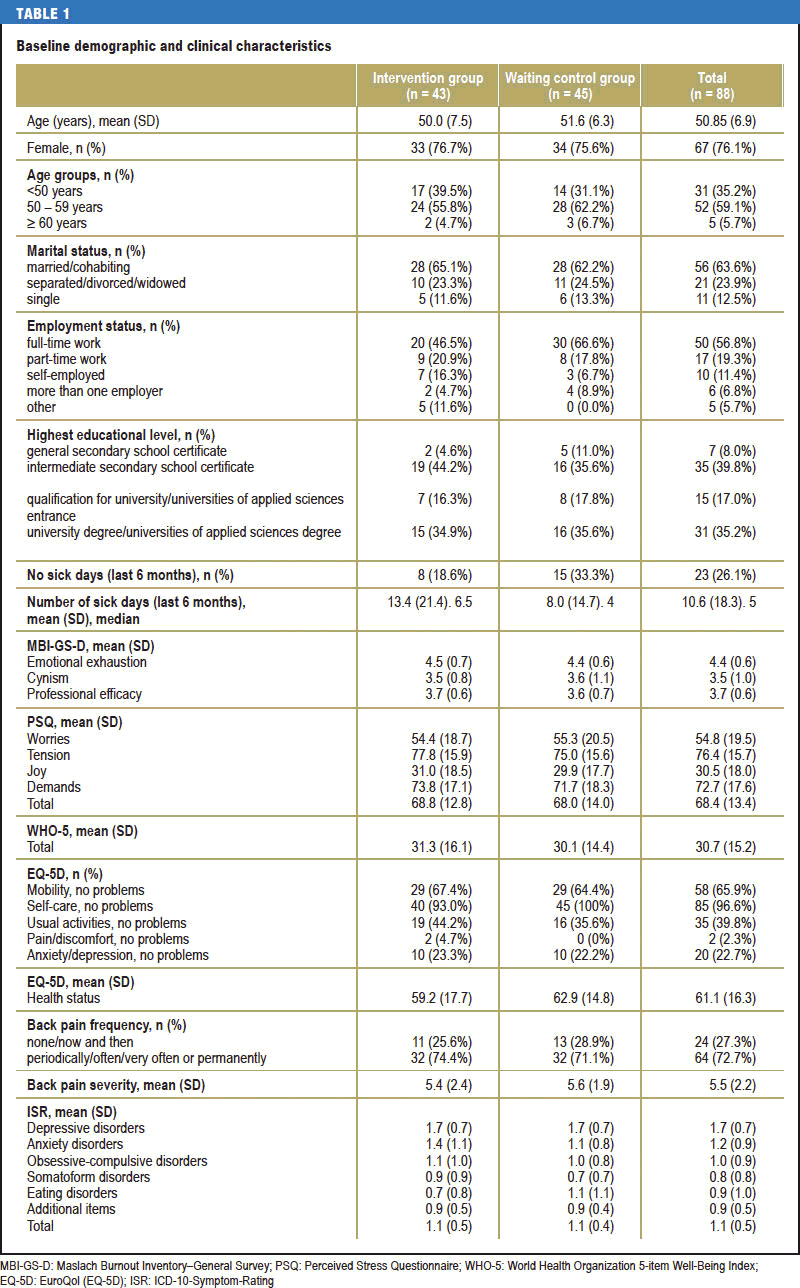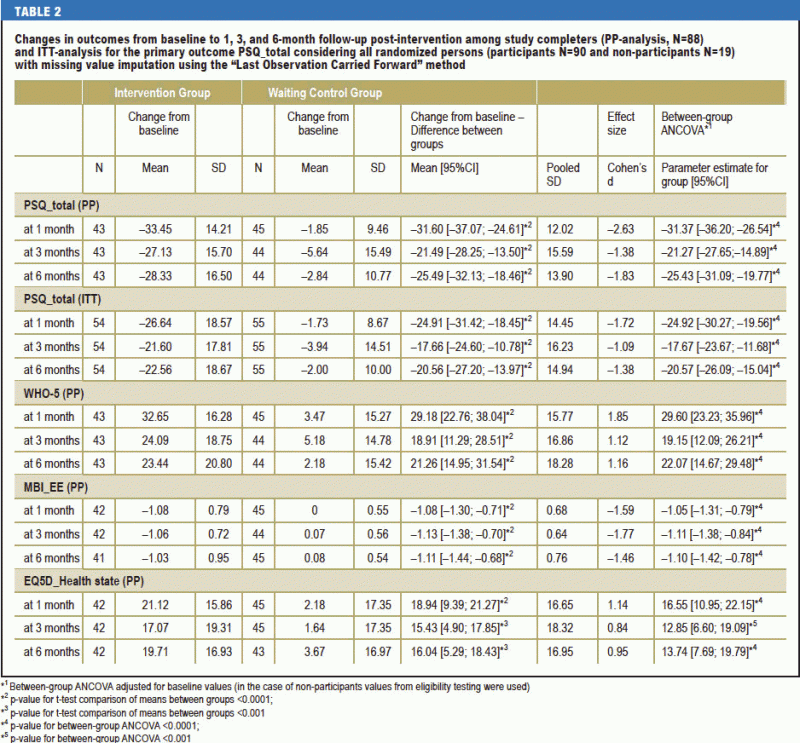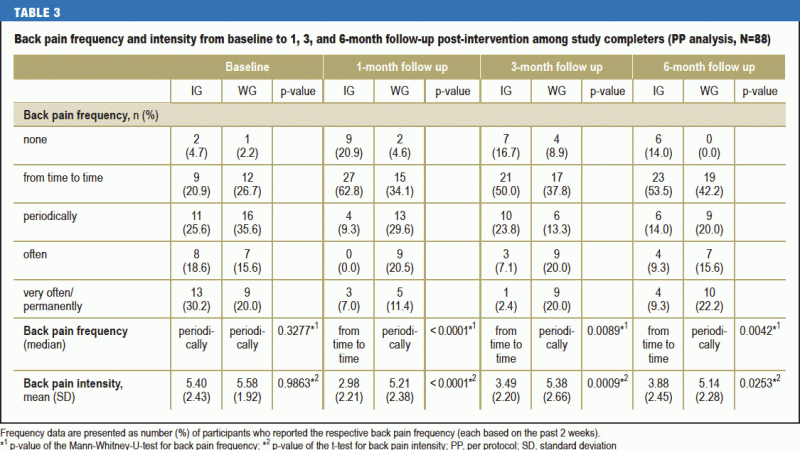The Effectiveness of a Stress Reduction and Burnout Prevention Program A Randomized Controlled Trial of an Outpatient Intervention in a Health Resort Setting
Public Health und Versorgungsforschung
Institut für Medizinische Informationsverarbeitung, Biometrie und Epidemiologie – IBE
Ludwig-Maximilians-Universität (LMU) München
Marchioninistr. 17,
81377 München, Germany
marita.stier-jarmer@med.lmu.de
Keywords
Article abstract
Background: Chronic psychological distress appears to have increased in recent years, mainly among the working population. The data available indicate that mental and behavioral disorders, including burnout syndrome, represent not only a personal problem for those afflicted, but also a serious public health issue. This study aimed at evaluating the effects of an outpatient burnout prevention program in a mono-center health resort setting.
Methods: Adults experiencing an above-average level of stress and thus being at an increased risk of burnout were randomized either to the intervention group (IG) or the waiting control group (WG). The 3-week program included stress management intervention, relaxation, physical exercise and moor applications. The primary outcome was change in perceived stress (PSQ) at 6 months post-intervention. Secondary outcomes included burnout symptoms, well-being, health status, psychological symptoms, back pain, and number of sick days. Participants were examined at baseline, post-intervention (3 weeks) and after 1, 3 and 6 months.
Results: Data from 88 adults (IG=43; WG=45) were available for (per protocol) analysis (mean age: 50.85; 76.1% female). Participants in the IG experienced significant immediate improvement in all outcome measures, which declined somewhat during the first three months post-intervention and then remained stable for at least another three months. Those in the WG did not experience substantial change across time. For the 109 randomized persons, results for PSQ were confirmed in an intention-to-treat analysis with missing values replaced by last observation carried forward (between-group ANCOVA for PSQ-Score at 6 months, parameter estimator for the group: –20.57; 95% CI: [-26.09; -15.04]). Large effect sizes (Cohen‘s d for PSQ: 1.09–1.72) indicate the superiority of the intervention.
Conclusions: The program proved to be effective in reducing perceived stress, emotional exhaustion and other targets. Future research should examine the long-term impact of the program and the effect of occasional refresher training.
Article content
Chronic psychological distress appears to have increased in recent years, mainly among the working population (1). The statistics of statutory pension insurance providers and health insurance providers show a rapid increase in mental health problems, such as fatigue, burnout and depression (2, 3). There is currently no general, internationally agreed definition of burnout (4, 5). According to most conceptions however, burnout is a long-term stress reaction characterized by persistent emotional exhaustion as a core symptom, cynicism/depersonalization and reduced personal accomplishment (4, 6).
Burnout is usually referred to in occupational contexts and has been described in numerous professions or groups of individuals (7–9). Burnout is known to be associated with considerable subjective suffering and a number of physical and mental health problems (10, 11), sleep disorders (12), reduced productivity and motivation (13) and an increased risk of sick leave (14).
Due to the lack of clearly defined diagnostic and classification criteria, burnout syndrome is statistically difficult to quantify. Its actual prevalence is unknown, with cases being most likely contained within the statistics on mental and behavioural disorders (ICD-10 F00–F99) (15, 16). The numbers of incapacity-for-work cases, the number of lost work days and the number of cases of early retirement due to mental disorders in Germany have increased considerably in recent years (2). Between 2008 and 2013, the number of days off work due to mental disorders increased from 41 million (9% of total work days lost) to 79 million days (13.9%) (17, 18). The proportion of mental and behavioral disorders (ICD-10 F00–F99) leading to early retirements amounted to 24.2% in the year 2000 and had increased to 43.1% by 2014 (3).
These data indicate that mental and behavioral disorders, including the burnout syndrome, represent not just a personal problem for the individual patient, but also a serious public health issue. Given the high human and financial costs, it is important to identify chronic stress in its early stages and to prevent fully developed burnout, even if the extent of its contribution to the burden of mental illness in Germany remains unclear.
Over the past years, numerous efforts have been made to develop effective interventions aimed at reducing occupational stress and preventing burnout (7, 19–21).
Chronic stress and burnout seem to be inseparable. There is no conceptual limitation where stress management ends and burnout prevention begins. The main focus of burnout prevention should, therefore, be on the optimization of stress-management skills (22).
As far as we know, our study is the first attempt to develop a preventive program for people at risk of burnout by combining traditional, outpatient health-resort treatments (HRT) with stress-management interventions (SMI).
Health-resort medicine (23) comprises treatment with local natural remedies, such as medical mineral waters or peloids combined as required with physical therapy interventions, exercise and relaxation therapies, among others. Outpatient preventive and rehabilitation treatments in German health resorts are approved and covered by the statutory health insurance. The length of stay at a resort is typically three weeks.
The objective of our study was to develop, implement and evaluate a 3-week program combining SMI with HRT and aiming at reducing the participants’ currently perceived stress, activating subjective resources, initiating initiating recovery processes for both body and mind and providing strategies for dealing with stressors in everyday life. We designed and conducted a prospective, randomized controlled trial (RCT) with a 6-month follow-up to study the effectiveness of the program.
Methods
Details on inclusion and exclusion criteria, intervention, sample-size estimation, and missing data handling are provided in the eBox.
The study was designed as a two-arm RCT with follow-up measurements pre- and post-intervention (T0, T1) and at 1-, 3-, and 6-months post-intervention, respectively (T2–T4) .
The study population was defined as individuals with an above-average level of stress who were at increased risk for developing a burnout syndrome. Interested persons, recruited through printed and electronic advertisements, were invited to complete two screening questionnaires:
- the Maslach Burnout Inventory–General Survey (MBI-GS-D) (24, 25), and
- the Perceived Stress Questionnaire (PSQ) (26, 27).
Eligible persons were randomly assigned in a 1:1 ratio to either the intervention (IG) or waiting control group (WG) using permuted blocks of ten. The IG participated in a 3-week prevention program including SMI, relaxation techniques, physical exercise, and moor baths. The WG served as an untreated comparison for six months, before taking part in the same program.
Outcomes and Measures
The primary outcome was perceived stress (PSQ) at T4. The following standardized instruments were used to measure
- burnout symptoms—MBI-GS-D,
- well-being—World Health Organization 5-item Well-Being Index (WHO-5) (28),
- health status—EuroQol (EQ-5D-5L) general health index (29) and
- psychic symptoms—ICD-10-Symptom-Rating (ISR) (30).
The frequency and intensity of back pain (T0–T4) and the number of sick days during the previous six months (T0+T4) were recorded.
Data analysis
Sample size estimation revealed a minimum of 90 participants, allowing for drop outs.
Data analysis was performed for all participants who completed both the baseline assessment and at least one follow-up (per protocol (PP) analysis). For the primary outcome, in addition, an intention-to-treat (ITT) analysis was conducted. Effects were judged significant at p<0.05 (two-sided).
Baseline measurements and demographics were compared between groups using the independent samples t-test for metric and Pearson’s chi-square test for categorical variables. Changes in primary and secondary outcomes after the intervention and within the 6-month follow-up were compared between groups using t-tests or Mann-Whitney U-Tests and ANCOVA (with adjustment for baseline values). Standardized effect sizes (Cohen’s d) were calculated as the difference between two means divided by the pooled standard deviation.
Results
Figure 1 shows the flow of included and excluded participants throughout the study. The response rate for follow-up was 100%. Demographics and clinical variables of the final groups of participants are presented in Table 1. There were no statistically significant differences between groups at baseline in terms of demographics and outcome variables considered.
The mean age was 50.9 years (±6.9). Most participants were female (76.1%), married or cohabiting (63.6%), and highly educated. Almost all participants were in paid employment (94.3%). They represented a wide range of occupations, including e.g. healthcare professionals, administrative employees, and commercial staff. With one exception, all participants were insured by the statutory health insurance Barmer GEK. The mean number of sick days during the previous six months was 10.6 (±18.3) per participant. 26.1% had no sick days during that period. The average PSQ_total at baseline was 68.4 (±13.4), which was considerably higher than in healthy adults with a mean of 33 (27). Participants had a mean MBI-EE of 4.4 (±0.6). Among the psychological symptoms, the highest values were found in the depression (M 1.7 ± 0.7) and the anxiety (M 1.2 ± 0.9) scales. Both values can be interpreted as symptoms of low-to-medium levels of strain.
Change in PSQ_total and secondary outcomes
Results regarding the changes over time in PSQ_total and secondary outcomes compared between groups are presented in Table 2 and Figure 2. While there were no significant differences in means found across the groups at baseline, the mean change scores (changes compared to baseline) differed significantly between them at all post-intervention time points. The participants in the IG showed significant improvements compared to the controls. ANCOVA revealed significant effect between groups (PSQ_total at T4 in PP-analysis: –25.43; 95%CI [-31.09; -19.77]), confirmed by ITT-analysis (-20.57; 95%CI [-26.09; -15.04]). Large effect sizes, even in ITT-analysis (Cohen‘s d for PSQ_total 1.09–1.72), indicate the superiority of the intervention group compared to the waiting control group.
At baseline, 96.6% of participants reported having had back pain during the previous two weeks. The mean pain intensity was 5.5 (± 2.2). Compared to the WG, the participants in the IG showed significant decreases in both the frequency and intensity of back pain post-intervention and during follow-up (Table 3).
Both groups had fewer sick days during the 6-month follow-up (median IG=1, WG=2) compared to the 6-month period prior to the start of the study (median IG=5, WG=4). There was no statistically significant difference between the two groups. No adverse events were reported.
Discussion
The multimodal prevention program aimed at reducing currently perceived stress, but also at providing strategies for dealing with stressors in everyday life and, thus, enabling participants to help themselves in the long run.
Participants were 76% female, on average 51 years old, and most had a higher education. This corresponds to the results of population-based Scandinavian studies, where higher levels of burnout and exhaustion were associated with female sex (31), being older (>50) (8, 31) and having either a higher education or no education (8).
Participants of the IG experienced significant immediate improvement in perceived stress and secondary outcomes, which declined somewhat during the first three months post-intervention and then lasted for at least another three months, while the WG did not change substantially across time. Change over time in the IG yielded large effect sizes, suggesting significant improvement in psychological functioning post-intervention and over the course of the follow-up. The results of an ITT-analysis for PSQ_total are consistent with the primary PP-analysis.
Many studies have recently been conducted on the effectiveness of interventions that aim at reducing occupational stress and/or preventing burnout (7, 19–21).
Our study has a lot in common with these studies: the study population was mainly female and consisted of individuals from a wide range of occupations with increased stress levels and/or at risk of burnout; a secondary preventive approach was generally applied; burnout, stress and mental health were target outcomes; and cognitive behavioral intervention (CBI) was a key intervention. In contrast, differences exist in both the nature and scope of the interventions and in their duration.
Most burnout–prevention studies investigated the effects of person-directed interventions involving measures such as CBI, communication training, relaxation and others. In 75% of these person-directed studies, burnout decreased significantly (20). Even research on the effects of occupational stress-management interventions included CBI, which was the second-most-common intervention (56%) after relaxation and meditation techniques (69%). Often both forms of therapy were combined. CBIs were found to consistently produce larger effects than other types or combinations of interventions (21). Physical exercise as a stress-reducing measure was rarely investigated.
The majority of these studies included intervention periods of several weeks or months. It can be assumed that most of the treatment sessions were held intermittently at the place of residence or work. This differs greatly from our 3-week treatment at a health resort, which not only offered a comprehensive multimodal program, but also a spatial distance from home and work, which gave participants the opportunity to get away from the stressors of daily life.
One previous study examined the effectiveness of health resort treatments on work-related burnout (32). The treatment offered in this research project was not primarily designed as burnout prevention. Participants were at the Austrian health resort because of musculoskeletal complaints, but also showed symptoms of burnout. They received the usual individualized spa treatment. A specific SMI was not carried out. Considerable improvement in burnout-related complaints was achieved and lasted up to three months. However, the lack of a control group greatly limits the validity of these results.
The improvements seen in our study are altogether comparable to previous research. The results in Table 2 reveal large effect sizes for perceived stress, well-being, emotional exhaustion, and general health during the 6-month follow-up. Richardson and Rothstein show in their meta-analysis of 36 studies evaluating the effectiveness of SMIs that CBIs are the only interventions with similarly large effect sizes. In contrast, multimodal interventions comprising cognitive-behavioral or relaxation components or both yielded significant, albeit small, effect sizes. Interestingly, they found that the more components were added to a CBI, the less effective it became (21). This is contrary to our findings, in which a multimodal intervention including SMI, relaxation, physical exercise and moor applications was highly effective in reducing perceived stress and burnout symptoms in the short-to-medium term.
It can be assumed that the 3-week absence from home and work also contributed to the observed changes. Previous research has found that respite from work and the daily workload has small, but positive, effects on health and well-being and can reduce perceived stress and experienced burnout. The recovery effects, however, are of short duration. Both, perceived stress and burnout symptoms, decrease during vacation and increase after returning home (33, 34).
Our present study could not answer the question of whether the program is more or less effective for particular subgroups (e.g., differentiation according to age group, sex, educational background, etc.). Longitudinal data analyses based on the whole data set will be conducted to examine this partial aspect.
The question of which specific interventional measures are essential for efficiently reducing stress and burnout was not investigated in the scope of this study. In previous studies, stress-reducing or anti-depressive effects were demonstrated for most therapeutic measures applied in our prevention program (35–39). However, previous research on burnout prevention suggests that SMIs could play a crucial role (20).
Limitations to this study comprise the potential bias of self-report and the lack of additional parameters known to potentially influence perceived stress and burnout symptoms (e.g., personality traits, social support). The use of a voluntary sample may include only the most motivated people, and therefore limits the generalizability. The WG design is controversial because of the potential overestimation of treatment effects. Nevertheless, it is a common and sensible approach in the evaluation of SMIs (21) providing advantages in ethical (guarantees treatment) and methodological (controls for time, regression to mean, and expectancy of improvement) terms (40). As a final point, the possibility cannot be excluded that results may be biased due to the lack of blinding, which is not feasible in a trial with WG design.
Strengths of the study include the use of well-validated assessment tools, the conscientiousness of the participants, the impressive response rate and completeness of data, as well as the low drop-out rate.
As noted above, our study participants were selected based on their level of perceived stress and the extent of burnout symptoms. It is uncertain whether the results of this study can be generalized to all populations at risk of burnout. For our study population, however, we could clearly show the feasibility of this health-resort-based program, its positive effects on perceived stress and other health-related outcomes and its high general acceptance.
Acknowledgments
We wish to offer our sincere thanks to all our study participants for their commitment and patience, which made the success of our study possible. A tribute also needs to be paid for the valuable support in conducting the study on site provided by our colleagues Gisela Immich and Michaela Kirschneck.
Compliance with Ethical Standards
The study was approved by the Ethics Committee of the Ludwig-Maximilians-Universität München, Germany (study no. 547–13). Informed consent was obtained from all individual participants included in the study.
Registration
German Clinical Trials Register: DRKS00009625
Conflict of interest statement
The study was funded by the Bavarian State Ministry of Health and Care (Grant No. K1–04–00014–2012-EA_BayGA). Applicants in this scheme, in this case the health resort administration of Bad Aibling (AibKur), have to provide a financial contribution of 30% of eligible expenditure. The costs of medical and therapeutic services were covered by Barmer GEK.
The funding agencies had no influence on the planning and course of the study or on the evaluation and publication of its findings.
The Chair of Public Health and Health Services Research, LMU has received study support (third-party funding for the research project).
All authors declare that no conflict of interest exists.






